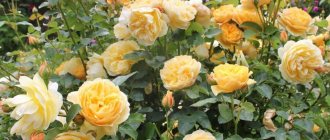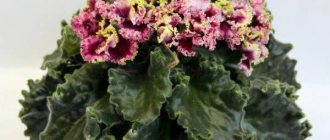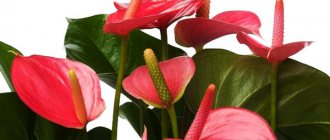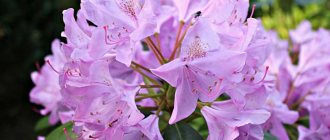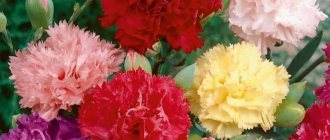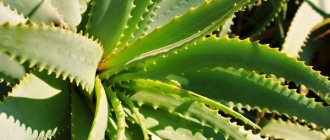Greetings, dear flower growers! I don’t know about you, but along with beautifully flowering house plants, I really love decorative foliage plants. And here my favorite is chlorophytum, the types and varieties with photos of which will be given in the article.
Why does he attract me? Unpretentiousness, decorativeness, variety of leaf colors and some special modest beauty.
Let's not forget about the beneficial properties of the plant, its ability to purify the air, moisturize it, creating a very comfortable microclimate in the room. And I really hope that many of those who were somewhat skeptical about this flower will change their minds and definitely choose a variety to grow.
Botanical features and homeland of the plant
Currently, more than 200 species of chlorophytum are known. Under natural conditions, the flower grows in warm climates. South Africa is considered to be its homeland. Now the plant is widespread in the tropical zones of the Earth.
Chlorophytum is a herbaceous ornamental perennial with a short stem and a tuberous root system. Leaves are rosette type, oval or lanceolate. The flowers are white, medium-sized. In indoor floriculture, chlorophytum is used as an hanging plant, in single and group plantings.
Climbing indoor flowers
The vines and ivies that climb the interior walls of the rooms create an unrealistically beautiful effect. The house is filled with lightness and freshness. With the help of climbing plants you can create a real paradise in your home.
Monstera
A plant that will quickly spread its aerial roots onto any pole or net and tightly entwine the space allotted for it with huge leaves of an unusual carved shape.
Cissus
Cissus is an ornamental plant of the grape family, native to tropical islands. With its antennae, the cissus clings to the supports and crawls along them. The clear advantage of this climbing plant is that it blooms all year round.
Tricolor morning glory
Outdoor morning glory is an annual plant, but its indoor species will grow in the house for many years. Morning glory has very large, bright green leaves and blooms with colorful flowers.
Wax ivy Hoya
If you put a minimum of effort into gartering and replanting, you can cover your home wall with a very impressive look of ivy. Hoya flower umbrellas have an unusual appearance, their surface is perfectly glossy, as if each leaf was carefully covered with a thin layer of wax.
Stephanotis
A very beautiful and large vine, the second name of which is Madagascar jasmine. Stephanotis delights with flowers of pale pink and purple shades, which exude a delicate aroma similar to the smell of street jasmine.
Syngonium
A one and a half meter plant that quickly climbs supports. Different varieties have different foliage colors - from cream to variegated combined colors. The peculiarity of any type of syngonium is that the older the plant becomes, the more bizarre the shape of its leaves becomes.
Dipladenia Mandeville
A tropical climbing plant covered with large (up to 10 cm in diameter) flowers. Dipladenia feels great not only indoors, but with its help you can weave balconies, loggias, verandas and gazebos.
Types and varieties
Several varieties of chlorophytum have become widespread in indoor floriculture. Plant species and varieties differ not only in shape and structure, but also in the basic color of the leaves.
| Species name | Latin name | Botanical description | Peculiarities | The best varieties |
| Crested or tufted | Comosum (Thunb.) Jacques | The stem part is short. The leaves are light green in color, linear, arched, collected in basal bunches with white and star-shaped flowers | The easiest species to grow indoors | Variegated Comosum var. Variegatum, compact Comosumvar. Mandainum, Spiral Curty Locks |
| Cape | Capense (L.) Voss. | The leaves are narrow-lanceolate, linear, narrowed towards the base and apex, light green, glabrous, collected in a basal rosette. | A powerful and well-developed perennial plant with a pronounced tuberous thickening of the root system; without formation of rosettes | – |
| Winged or orchid star | Amaniense Engl., or Ch. orchidastrum | Short. The leaves are wide, oval, lanceolate and grooved, dark green | Petioles pink, red or red-orange | Green Orange, Fire Flash |
| Laxum | Laxum | The leaves are thin, narrow, drooping, with a white stripe along the edge. Doesn't produce children | Ability to adapt to any conditions of detention | – |
The most popular forms of chlorophytum cultivated in home floriculture include several varieties with excellent decorative properties.
| Variety | Variety name | Varietal features |
| Сomosum | "Variegatum" | The leaf edge is decorated with light cream stripes |
| Сomosum | "Vittatum" | Along the central vein, along the entire length of the leaf blade, there is a white stripe. |
| Сomosum | "Mboyeti" | Waviness of leaf edges |
| Сomosum | "Atlantic" | Narrow curly leaves |
| Сomosum | "Ocean" | The aerial part consists of sharp lanceolate leaves with a pronounced white border on the edge |
| Сomosum | "Bonnie" | Narrow, shortened leaves are twisted into a spiral, and in the middle part of the leaf plate there is a wide light stripe |
| Amaniense | "Green Orange" | The petioles are bright orange in color, and in the central part of the leaf blade there is an orange longitudinal vein characteristic of the variety. |
| Amaniense | "Fire Flash" | The petioles are bright orange in color, and in the central part of the leaf blade there is a not too pronounced longitudinal vein of orange color. |
| Сomosum | "Curty Locks" | Spiral-twisted striped leaves |
| Сomosum | "Maculatum" | A very compact plant with longitudinal yellow stripes on the leaves. |
| Сomosum | "Mandaianum" | Pronounced longitudinal yellow stripe on the leaves |
Most varieties and varieties form simple white flowers, and after flowering, aerial rosettes are formed, suitable for further propagation of indoor crops.
Varieties
In total, there are about 200 species of chlorophytum in nature. Their names usually reflect the characteristics of their leaf blades.
- Crested or komosum. The most famous type of chlorophytum, with long and narrow emerald leaves. In the center of each leaf blade there is one bright white wide stripe or several narrow stripes. When a flower shoots out an 80-100 cm arrow, 5-7 white flowers appear on it. After they fade, a “baby” appears at the end of the airy whisker.
- Curly (Bonnie). This variety of chlorophytum leaves reach 60 cm in length and no more than 3 cm in width. The leaves form dense basal rosettes, from which short, numerous flower stalks are produced. This species does not form long airy whiskers with “babies”, so its reproduction occurs by dividing the mother bush.
- Cape. This variety is very similar in appearance to Chlorophytum curly, but its leaves are much longer - from 90 to 100 cm. But, like Bonnie, it does not produce flower stalks and does not form “babies”. Reproduction occurs by dividing the mother bush.
- Winged or orange (orchid star). Only an experienced gardener will recognize this plant as chlorophytum, since it is completely different from related species. Its leaf blades are wide, elliptical in shape, pointed at the ends. It reaches a height of 30-40 cm. The leaf petioles are fleshy and bright orange, which is why this species got its name. The central vein, as well as the warp of the leaf blades of young leaves, are orange. Over time, the leaves, with the exception of the central part, become completely green. The peduncles are short, the flowers are collected in inflorescences resembling a cob. “Children” are formed at the base of the mother bush.
In order for the flower to always retain its rich orange color, you should cut off the extra “babies” and flower stalks, on which the plant consumes water and nutrients.
- Variegated . This variety was bred by breeders. It is distinguished by leaves with stripes of white, yellow and cream tones. Forms long airy mustaches with “babies”.
- Laxum . The rarest type of chlorophytum. Forms a dense basal rosette of leaves, but does not form airy mustaches. Unlike other species, it reproduces well by seeds. The leaves are narrow - no more than 1.5 cm, framed along the edges with white stripes.
Winged chlorophytum and laxum
The winged one differs from its fellows in appearance. From the central part of a small rosette emerge wide grooved leaves of a dark green hue, tapering at the top and bottom. Small stems are pinkish or orange. The shoots with flowering rosettes are short. If you want to preserve the bright shades of foliage, then the flower stalks must be removed. You can leave a few of them to obtain seeds. The ornamental plant attracts attention with the contrast of dark green leaves and pinkish-orange petioles. Among the winged chlorophytums there are many original and interesting varieties. For example, “green orange” attracts with its bright contrast of orange petioles and green leaves.
Chlorophytum "orange" is characterized by wide, dark-colored leaves combined with bright stems. Given the sensitivity of the foliage to chemicals, you only need to treat the soil, making sure that the chemicals do not get on the leaf blades.
To prevent chlorophytum “orange” from losing its color, you need to select diffused lighting for it.
Laxum is a rather rare plant with narrow leaves forming a dense bunch. The edge of the leaf blade is bordered by a thin white stripe. Chlorophytum laxum does not reproduce by shoots, but often pleases with the formation of inconspicuous white flowers.
Fairly simple care at home allows you to grow many varieties of chlorophytum without any problems. Moderate temperatures, sufficient watering and diffused sunlight are the ideal conditions that chlorophytum requires. It can withstand variable temperatures, dry days, direct sunlight, and a small amount or excess of minerals. However, it is better to avoid such extreme conditions, as they will certainly affect the appearance of the plant. In spring you can feed the flower with complex fertilizer. It is recommended to replant annually in early spring into spacious containers that allow the roots of the plant to grow.
Reproduction
It is possible to propagate chlorophytum in different ways.
- "Children." Chlorophytum mainly reproduces by small bushes formed on airy tendrils. Usually these bushes are called “babies”. For rooting, it is enough to cut off even a very small “baby” from the airy tendril and place it in moist soil. You can place it in water and wait for the young rhizomes to appear, and then transfer it to the ground.
It is best to plant “babies” at the end of winter - beginning of spring, before the start of the period of active plant growth.
- Seeds. Propagation by seeds is not very popular among gardeners, since this procedure is troublesome, and the germination rate of seeds is quite low - no more than 30 percent. It is better to plant in the spring, when there is active daylight. For better germination, seeds are soaked in gauze a day before planting. Sand and peat soil is prepared in pots, into which planting material is placed to a depth of 5-7 mm. The soil is moistened and covered with film.
Before emergence, greenhouses are kept in a slightly dark place at a temperature of 22-25 degrees Celsius. Crops must be ventilated and moistened daily by spraying to prevent the seeds from being washed out. After 4-6 weeks, single shoots appear.
Seedlings should be opened gradually, increasing the time spent in the light every day. When the seedlings have 2-3 true leaves, they are planted in separate small pots.
- Dividing the bush. Chlorophytum should be divided during spring replanting if the rosette of the mother bush grows excessively. The bush removed from the pot is divided into four equal parts with a sharp knife, the cut areas are sprinkled with charcoal and planted in separate pots.
Reviews and recommendations from flower growers
Particularly popular now is a new product on the flower market - Chlorophytum orchidastrum Green Orange. The Ocean variety, which is a compact, bright bush with yellow-green leaves, is no less in demand. Chlorophytum crested Ocean, as well as varieties Variegata and Lemon, will become a real decoration of any flower collection. Chlorophytum is characterized by rapid growth and is considered one of the most unpretentious indoor plants. However, in summer the flower requires abundant watering. According to reviews from experienced gardeners, windows facing east or west are optimal for growing indoor chlorophytum.
The plant needs bright but diffused lighting. Variegated varieties of chlorophytum cannot be cultivated in the shade: due to lack of lighting, the plant loses its decorative coloring.
Young plants need to be replanted annually, and adults - once every 2-3 years. Transplantation is carried out at the end of winter or beginning of spring.
In spring and summer, small white flowers form on thin stalks, followed by rosettes that can be separated from the parent plant and rooted.
Chlorophytum is called the “green indoor healer”: it helps purify the air from harmful substances and improve indoor humidity, which partly explains its enormous popularity.
Home care rules
Chlorophytum is so loved by many gardeners because it is completely unpretentious in care. To always maintain a neat and attractive appearance of a flower, it is enough to follow simple conditions for its maintenance.
- Watering. It is better to water the flower with settled water at room temperature (or slightly cooler) as the soil dries. However, if the flower is left for 1-2 weeks without watering, it will not die. The leaves may turn pale and lose turgor, but after watering their decorative qualities will be restored. In addition to regular watering, chlorophytum needs to be sprayed with water at least once every 2 weeks and the leaves must be wiped from dust with a damp cloth.
You can also wash the flower in a low-pressure shower. Excessive moisture will not harm it.
- Lighting. Chlorophytum is classified as a shade-tolerant plant, so it is often placed on cabinets, refrigerators and other places where direct sunlight does not reach. Excessive lighting is harmful to the flower; it leads to wilting and yellowing of the leaves. But if you place a flower on the windows of the north side of the apartment, it will feel good.
- Temperature conditions. Chlorophytum is not particularly sensitive to room temperature and its changes. As with many indoor plants, prolonged exposure to temperatures below +16 degrees can be detrimental to it. But in general, it has a very wide climatic comfort zone, and it grows well at temperatures from 20-22 to 30-35 degrees Celsius.
- Soil and fertilizing. This plant is completely unpretentious to the soil in its pot. It feels good both in a light substrate with a high sand content, and in soil rich in organic compounds, peat and humus. Chlorophytum is particularly insensitive to acidity, but excessive acidification of the soil can negatively affect its health.
Plants similar to chlorophytum
Quite often you can find ornamental plants that resemble chlorophytum in appearance and are just as easy to care for.
| Name | Botanical description | Features of flowering | Advantages and disadvantages |
| Billbergia | Forms a long tubular rosette of hard leathery, single-colored or variegated, narrow and elongated leaves covered with medium-sized scales | Attractive flowers with bright petals | Beautiful flowering, highly decorative, low maintenance |
| Ophiopogon | Leaves are sessile, linear or narrowly lanceolate, up to 20 cm long. The color is most often purple | The inflorescences are short, spike-shaped, with attractive small flowers of white or purple color. | Fairly high decorative value and good shade tolerance |
| Aspidistra | It has an underground creeping rhizome, dark green glossy leaves on long broad oval petioles | Flowers are sessile, not particularly attractive, perianths are brown-violet | Unpretentiousness, durability and good shade tolerance |
| Beaucarnea | Single-stemmed or weakly branched, slow-growing evergreen tree plant. Due to the shape of the trunk, which resembles a bottle, it is also called “elephant’s foot” and “bottle tree.” | Flowers green-white, numerous, small | |
| Narrow furrow (Stenotaphrum) | A perennial low plant with creeping above-ground shoots rooting at the nodes | Inflorescences are spike-shaped, relatively attractive | A very promising and popular lawn plant |
| Arundinaria | It has belt-shaped, hard leaves of unusual color adjacent to the beginning of the stem. Also called "house bamboo" | Inflorescences racemose or paniculate, with small flowers | A spectacular ornamental plant that forms a beautiful lush bush |
It should be remembered that almost all heat-loving indoor crops need sufficient lighting, but some of them cannot tolerate direct sunlight.
Beneficial features
It is no coincidence that chlorophytum is one of the most popular houseplants. In addition to its excellent decorative qualities, it also has some useful properties.
- Air purification. This flower absorbs not only carbon dioxide more effectively than many others, but also assimilates carbon monoxide, acetone vapor, formaldehyde and nicotine in its leaves. Therefore, it is highly recommended to keep it in the kitchen and in rooms often smoky with tobacco smoke, as well as where there is a lot of furniture made of chipboard, since it emits formaldehyde in small doses.
- Air humidification. Chlorophytum intensively collects and evaporates moisture, therefore it is a natural air humidifier. This is very useful for people with various pulmonary diseases and for maintaining youthful skin. According to statistics, one flower humidifies the air in an area of 2 square meters around itself.
- "Family happiness". According to Feng Shui, this flower is good to keep in the house to maintain a calm family environment and bring harmony to your personal life.
- Good for pets. Owners of cats and small dogs sometimes grow chlorophytum for their pets, as this flower helps cleanse the stomach, is absolutely harmless to them, and also contains some useful vitamins.
For the beneficial properties, care and propagation of chloroitum, see below.
Indoor flowers for children
Young children have a keen sense of nature and are drawn to it. Therefore, it is worth placing a living plant in their room that they can study and enjoy caring for. But this flower should be harmless, and even better, useful for the child.
Lemon Tree
Decorative lemon is an excellent solution for a children's room. The tree goes through the entire cycle: from flowering to small fruits, which will delight any young naturalist. In addition, the leaves release essential oils, which are very beneficial for breathing and disinfect the air.
Violet
A miniature and not picky violet can fit perfectly into the interior of a children's room. It has velvety leaves and small beautiful flowers that a child can use in creativity and even decorate culinary masterpieces.
Tradescantia
A plant with beautiful colorful leaves makes children very happy. In addition, this plant is so harmless that it is even eaten.
Cypress
A very good option for a children's room. Cypress has antiseptic and repellent properties. And the appearance of a miniature soft Christmas tree is very attractive to kids.
Peperomia
Peperomia also has antibacterial properties and its foliage contains phytoncides that kill fungi and mold. Many pediatricians recommend keeping this plant if the child has a weak immune system or suffers from pulmonary diseases.
Decembrist
A bright plant that children love for its variegated foliage and bizarre shapes.


